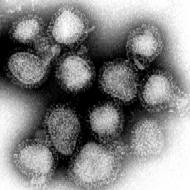User:Alex Blokha/HK Flu
| Influenza (flu) |
|---|
 |
The Hong Kong flu (also known as 1968 flu pandemic[1]) was a flu pandemic whose outbreak in 1968 and 1969 killed an estimated one million people all over the world.[2][3][4] It was caused by an H3N2 strain of the influenza A virus, descended from H2N2 through antigenic shift, a genetic process in which genes from multiple subtypes reassorted to form a new virus.
The first record of the outbreak in Hong Kong appeared on 13 July 1968. By the end of July 1968, extensive outbreaks were reported in Vietnam and Singapore. Despite the lethality of the 1957 Asian Flu in China, little improvement had been made regarding the handling of such epidemics. The Times newspaper was the first source to sound alarm regarding this new possible pandemic. There is a possibility that this outbreak actually began in mainland China before spreading to Hong Kong, but this is unconfirmed.[5]
By September 1968, the flu reached India, the Philippines, northern Australia, and Europe. That same month, the virus entered California from returning Vietnam War troops but did not become widespread in the United States until December 1968. It would reach Japan, Africa, and South America by 1969.[6] The outbreak in Hong Kong, where population density is greater than 6,000 people per square kilometre, reached maximum intensity in two weeks, lasting six months in total from July to December 1968. However, worldwide deaths from this virus peaked much later, in December 1968 and January 1969. By that time, public health warnings[7] and virus descriptions[8] were issued in the scientific and medical journals.
In comparison to other pandemics, the Hong Kong flu yielded a low death rate. [6]
This pandemic struck in two waves with the second wave being deadlier than the first in most places.[9]
The same virus returned the following years: a year later, in late 1969 and early 1970, and in 1972. The total worldwide death toll is estimated to have been in the region of one million people.
Clinical data[edit]
Flu symptoms typically lasted four to five days but some persisted for up to two weeks.[6]
Virology[edit]

The Hong Kong flu was the first known outbreak of the H3N2 strain, though there is serologic evidence of H3N1 infections in the late 19th century. The virus was isolated in Queen Mary Hospital.
Both the H2N2 and H3N2 pandemic flu strains contained genes from avian influenza viruses. The new subtypes arose in pigs coinfected with avian and human viruses and were soon transferred to humans. Swine were considered the original "intermediate host" for influenza because they supported reassortment of divergent subtypes. However, other hosts appear capable of similar coinfection (e.g., many poultry species), and direct transmission of avian viruses to humans is possible. H1N1 may have been transmitted directly from birds to humans (Belshe 2005).[10]
The Hong Kong flu strain shared internal genes and the neuraminidase with the 1957 Asian Flu (H2N2). Accumulated antibodies to the neuraminidase or internal proteins may have resulted in many fewer casualties than most pandemics. However, cross-immunity within and between subtypes of influenza is poorly understood.
Mortality[edit]
The United States Centers for Disease Control and Prevention (CDC) estimated that in total, the virus killed one million people worldwide.[11]
United States[edit]
The CDC estimated 100,000 people died in the U.S.[12] However, fewer people died during this pandemic than in previous pandemics for various reasons:[13]
- some immunity against the N2 flu virus may have been retained in populations struck by the Asian Flu strains which had been circulating since 1957;
- the pandemic did not gain momentum until near the winter school holidays, thus limiting the infection spreading;
- improved medical care gave vital support to the very ill;
- the availability of antibiotics that were more effective against secondary bacterial infections.
See also[edit]
References[edit]
- ^ Rogers, Kara (25 February 2010). "Hong Kong flu of 1968". Encyclopaedia Britannica. Open Publishing. Retrieved 18 March 2020.
- ^ Paul, William E. Fundamental Immunology. p. 1273. Archived from the original on 2 July 2014. Retrieved 27 October 2016.
- ^ "World health group issues alert Mexican president tries to isolate those with swine flu". Associated Press. 25 April 2009. Archived from the original on 27 April 2009. Retrieved 26 April 2009.
- ^ Mandel, Michael (26 April 2009). "No need to panic ... yet Ontario officials are worried swine flu could be pandemic, killing thousands". Toronto Sun. Archived from the original on 27 April 2009. Retrieved 26 April 2009.
- ^ Chang, W.K. "National Influenza Experience in Hong Kong, 1968" (PDF). WHO. WHO. Retrieved 12 April 2020.
- ^ a b c Starling, Arthur (2006). Plague, SARS, and the Story of Medicine in Hong Kong. HK University Press. p. 55. ISBN 962-209-805-3. Archived from the original on 18 June 2016. Retrieved 27 October 2016.
- ^ Jones, F. Avery (1968), "Winter Epidemics", British Medical Journal, 1968 (4): 327, doi:10.1136/bmj.4.5626.327-c, PMC 1912285.
- ^ Coleman, Marion T.; Dowdle, Walter R.; Pereira, Helio G.; Schild, Geoffrey C.; Chang, W. K. (1968), "The Hong Kong/68 Influenza A2 Variant", The Lancet, 292 (7583): 1384–1386, doi:10.1016/S0140-6736(68)92683-4
- ^ Rogers, Kara. "1968 flu pandemic". Encyclopedia Britanicca. Encyclopedia Britanicca. Retrieved 12 April 2020.
- ^ Chapter Two: Avian Influenza by Timm C. Harder and Ortrud Werner Archived 10 May 2016 at the Wayback Machine from excellent free on-line Book called Influenza Report 2006 which is a medical textbook that provides a comprehensive overview of epidemic and pandemic influenza.
- ^ "1968 Pandemic (H3N2 virus)". Archived from the original on 4 February 2020. Retrieved 12 March 2020.
- ^ "1968 Pandemic (H3N2 virus)". Archived from the original on 4 February 2020. Retrieved 12 March 2020.
- ^ "1968 Pandemic (H3N2 virus)". Archived from the original on 4 February 2020. Retrieved 12 March 2020.
External links[edit]
- Influenza Research Database – Database of influenza genomic sequences and related information.
